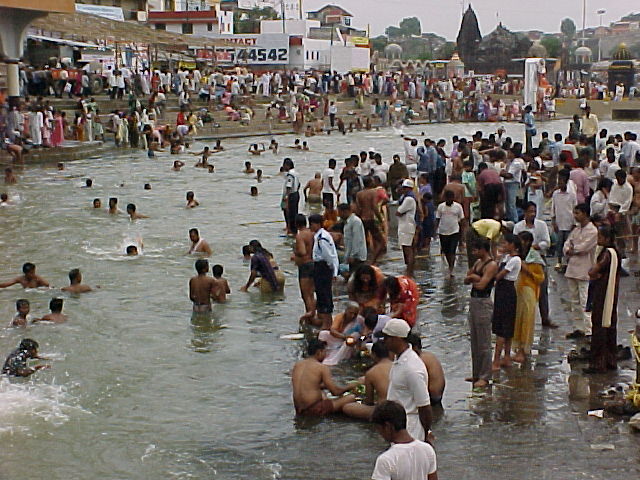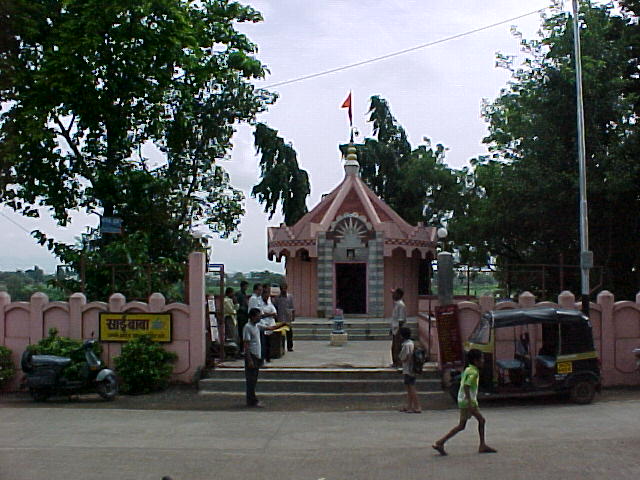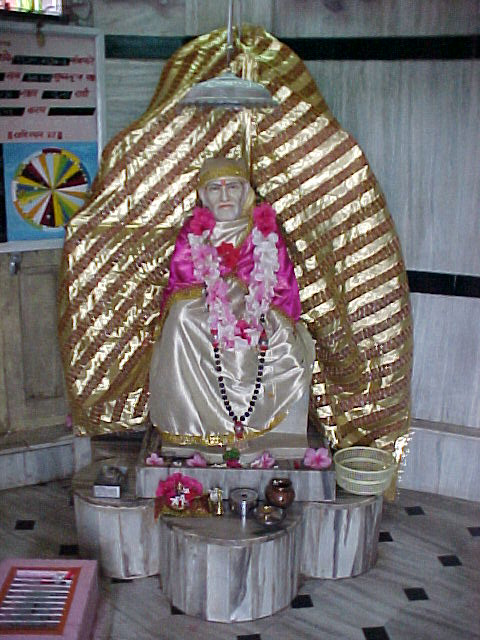
The Kumbha Mela (the Pot Fair) is celebrated in India at a twelve year cycle at Nashik, Allahabad, Haridwar, and Ujjain. The Kumbh started in Nashik on Wednesday July 30, 2003. At this great festival (it is said to be the largest gathering of humans anywhere) about a few million pilgrims will take a dip in the holy rivers of Godavari. Trimbakeshwar which is the holy place of one of the Jyoti Linga and about 50km from Nashik, is supposed to be the birth place of Godavari, the longest river of South India. Godavari river is much revered and referred to in the holy Shri Sai Satcharitra.
 According
to legends, once the gods and demons fought for a long time, but neither could
vanquish the other. In the meantime, they came to know a pot (Kumbha) of nectar
which was lying at the bed of the ocean that could make the drinker immortal.
For getting the nectar (Amrit), they put the fabled Mandara Mountain as a
churning rod and the great serpent Vasuki as the churning string. They eventually
found the pot of nectar but the battle among the gods and the demons continued
and during the struggle, a few drops of the nectar fell at Prayag(Allahabad),
Hardwar, Nasik and Ujjain. The war ultimately resulted in victory for the
gods and since then Kumbha Mela is held in these places every twelve years.
"Pilgrims plodded for months in the heat to get here, worn, poor and
hungry, but sustained by unwavering faith". So wrote Mark Twain, who
was perhaps the first American to attend the Kumbh back in 1885. Thousands
of foreigners also attend in the Kumbh not only to participate in the religious
fervor but also to study the planetary and inter stellar movements which occur
every twelve years during the auspicious time of Kumbh Mela. As Jupiter moves
from Cancer to Leo, it brings Pushkaram (the sacred days) to the river Godavari.
According
to legends, once the gods and demons fought for a long time, but neither could
vanquish the other. In the meantime, they came to know a pot (Kumbha) of nectar
which was lying at the bed of the ocean that could make the drinker immortal.
For getting the nectar (Amrit), they put the fabled Mandara Mountain as a
churning rod and the great serpent Vasuki as the churning string. They eventually
found the pot of nectar but the battle among the gods and the demons continued
and during the struggle, a few drops of the nectar fell at Prayag(Allahabad),
Hardwar, Nasik and Ujjain. The war ultimately resulted in victory for the
gods and since then Kumbha Mela is held in these places every twelve years.
"Pilgrims plodded for months in the heat to get here, worn, poor and
hungry, but sustained by unwavering faith". So wrote Mark Twain, who
was perhaps the first American to attend the Kumbh back in 1885. Thousands
of foreigners also attend in the Kumbh not only to participate in the religious
fervor but also to study the planetary and inter stellar movements which occur
every twelve years during the auspicious time of Kumbh Mela. As Jupiter moves
from Cancer to Leo, it brings Pushkaram (the sacred days) to the river Godavari.
It is believed that bathing during the Kumbh cures the bather of all sins and evils and grants the bather salvation. It is also believed that at the time of Kumbh Yog, the water of Godavari is charged with positive healing effects and that water at the time of Kumbh is charged positively by enhanced electro magnetic radiations of the planetary positions. As per Puranas (Hindu Scripts) properties of river water at Kumbh has been referred to as Amrit or elixir. In Kumbha Mela a number of tents or camps are established during the period where religious discourses, non-stop recitations of the Vedas, epics and the Puranas are held in the camps.
 The
first camp of Shri Shirdi Sai was established in the Maha Kumbh Mela in Allahabad
in 2001 under the guidance of Guruji Shri C.B.Satpathy by Shri Sai Baba Trust,
Lucknow and the tradition now continues with the second camp being established
in Nasikh in association and help of Shri Sai Baba Mandir Nasik, Shri Sai
Baba Trust, Lucknow and local devotees. A group of about 70 devotees from
Sai Palkahi group of Nasik will be volunteering throughout the camp days.
The
first camp of Shri Shirdi Sai was established in the Maha Kumbh Mela in Allahabad
in 2001 under the guidance of Guruji Shri C.B.Satpathy by Shri Sai Baba Trust,
Lucknow and the tradition now continues with the second camp being established
in Nasikh in association and help of Shri Sai Baba Mandir Nasik, Shri Sai
Baba Trust, Lucknow and local devotees. A group of about 70 devotees from
Sai Palkahi group of Nasik will be volunteering throughout the camp days.
During the camp days daily annadan, bhajans, Shri Sai Satcharitra parayan, Palkhi procession among other activities will be conducted at:
 Shree
SaibabaMandir
Shree
SaibabaMandir
Near Shriram Vridhashram
Tapovan, Panchvati, Nashik.
Phone: (+91) 253-2513051
For more information on Shri Sai Camp at Nashik Kumbh, please contact the local number in Nashik or send us an email at maildrop@saibaba.org with the subject line "Nashik Kumbh". For those who may be interested in visiting the Kumbh, click here to get more details on Nashik.

© 1996-2003 by saibaba.org, all rights reserved.